|
The Mysterious Glow of
Vaseline Glass
QUESTION:
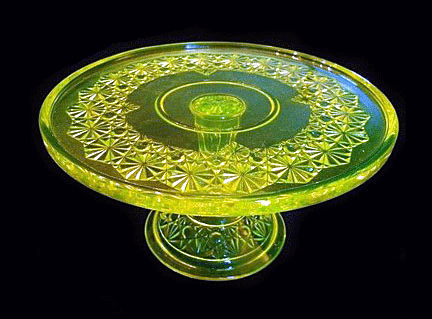 My
aunt recently died and left me several things, including two
beautiful twin yellow-green glass vases. I don’t know much about
them but someone said they’re made of Vaseline glass. Does that mean
they use Vaseline to make them? Can you tell me more about this
beautiful glass? My
aunt recently died and left me several things, including two
beautiful twin yellow-green glass vases. I don’t know much about
them but someone said they’re made of Vaseline glass. Does that mean
they use Vaseline to make them? Can you tell me more about this
beautiful glass?
Thanks,
Andrea
_________________________________________________________
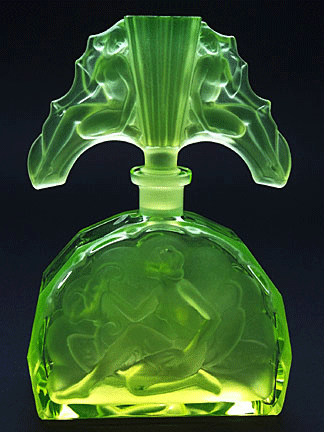 ANSWER:
No, your vases aren’t made of Vaseline. The most common color of this
type of glass is pale yellowish-green, which in the 1930s led to the
nickname "Vaseline glass" based on its resemblance to the appearance of
Vaseline brand petroleum jelly as was formulated and commercially sold
at that time. ANSWER:
No, your vases aren’t made of Vaseline. The most common color of this
type of glass is pale yellowish-green, which in the 1930s led to the
nickname "Vaseline glass" based on its resemblance to the appearance of
Vaseline brand petroleum jelly as was formulated and commercially sold
at that time.
The addition of uranium dates back to Roman times. Professor R. T.
Gunther of the University of Oxford discovered a piece of glass
containing one percent uranium dating to 79 C.E. in an excavation of an
imperial Roman villa on Cape Posillipo in the Bay of Naples, Italy in
1912.
Starting in the late Middle Ages, workers extracted pitchblende from the
Habsburg silver mines in Joachimsthal, Bohemia. This was then used as a
coloring agent in local glassmaking. Austrian druggist Franz Xaver
Riedel experimented with pitchblende and obtained a yellow substance
later identified as uranium dioxide. He added it to glass and became the
first major producer of items made of yellow-green uranium glass, which
he named "annagrün" (annagreen), in honor of his daughter Anna Maria. By
the middle of the 19th century, this new coloring agent became popular
in both Europe and America.
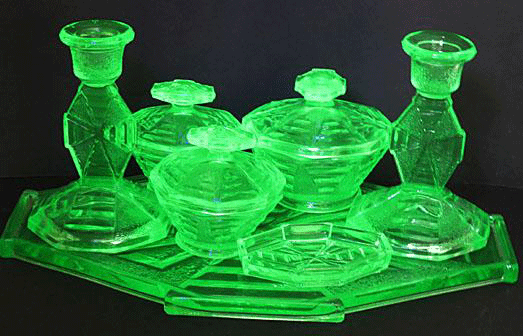
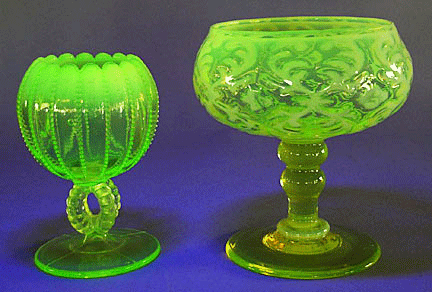 Vaseline
glass is also called "uranium glass." This mineral added to glass is
what makes it glow bright green under blacklight. The normal color of
uranium glass ranges from yellow to green depending on the oxidation
state and concentration of the metal ions, although this may be altered
by the addition of other elements as glass colorants. Vaseline
glass is also called "uranium glass." This mineral added to glass is
what makes it glow bright green under blacklight. The normal color of
uranium glass ranges from yellow to green depending on the oxidation
state and concentration of the metal ions, although this may be altered
by the addition of other elements as glass colorants.
That bit of uranium in the glass also makes it slightly radioactive.
With improvements in mass-produced, affordable glass, the popularity of
vaseline glass rose. During the second half of the 19th century,
interest in the glowing glass peaked. The fashionable glass was
appealing both in sunlight and in the evenings. Victorian homes were lit
by gaslight, kerosene or candles, which produced soft light-The human
eye sees yellow-green most easily since it is in the center of the
spectrum of colors, so under flickering light con. lit ions, the
Vaseline glass seems to glow.
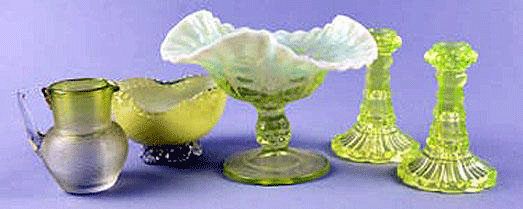
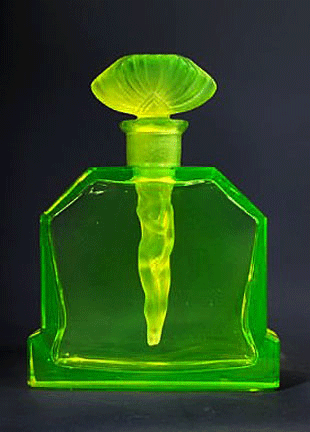 Large
glass companies like Fenton Glass and Moser Glass made vases, tableware,
tooth-pick holders, clocks, whimsies, shoes, hats, parasols, inkwells,.
compotes, and more in Vaseline glass. But between 1890 and 1910, the
middle class became more interested in pottery and porcelain. With the
development of Incandescent lighting, the steady light frequency made
Vaseline glass appear plain. Large
glass companies like Fenton Glass and Moser Glass made vases, tableware,
tooth-pick holders, clocks, whimsies, shoes, hats, parasols, inkwells,.
compotes, and more in Vaseline glass. But between 1890 and 1910, the
middle class became more interested in pottery and porcelain. With the
development of Incandescent lighting, the steady light frequency made
Vaseline glass appear plain.
The government confiscated all supplies of uranium during WWII for the
Manhattan Project and halted all production of vaseline glass for from
approximately 1942 until the ban was lifted in November 1958. From 1959
onward, glass companies began making vaseline glass again. However,
because of the expense to obtain uranium dioxide, production was and is
still very limited.
<
Back to Readers Ask Archives
Next Article >
|
